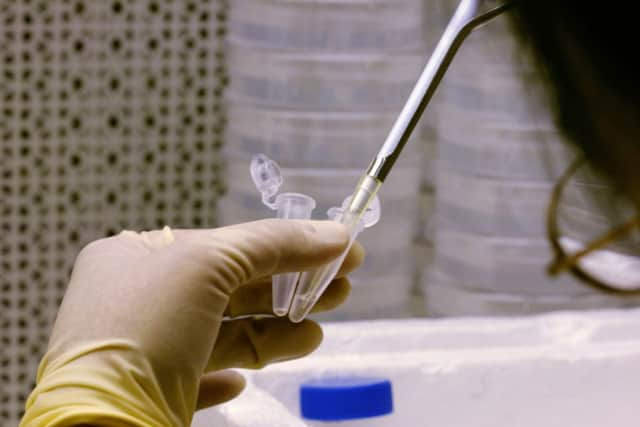US example for life sciences sector in Scotland


Anyone visiting Cambridge, Massachusetts, today would encounter a bustling city that appears to have been taken over by the biopharmaceutical industry.
However, in the 1970s, Cambridge was a very different place. A quiet city with a population of 100,000, lying north of Boston, but boasting two of the world’s leading universities, Harvard and the Massachusetts Institute of Technology (MIT), bringing a certain academic, hallowed feel to its historic squares. Fast forward 40 years, and Cambridge has become the “go to” place for drug companies seeking innovation.
Advertisement
Hide AdAdvertisement
Hide AdIt all started in the late 1970s, when MIT began to spin-out technology companies, initially focused mainly on IT, but increasingly in later years in biotechnology, as this new branch of life science gathered momentum. So the seeds were sown, providing the core ingredients for a thriving “biocluster”. Following closely behind the biotech companies came the “Venture Capital” (VC) investors, providing the money that helped turn companies such as Biogen from a small start-up in 1978 to a top 25 global pharmaceutical company by 2014. The final ingredient was “big pharma”, which has increasingly come to rely on the biotechnology industry and academic centres of excellence to feed their product pipelines. Heavyweights such as Pfizer, Novartis and Takeda are all currently building new research facilities in the heart of the city. The local economy has been transformed.
Is this relevant to Scotland? Well, like Cambridge, Scotland has many of the core ingredients necessary for a thriving biocluster. Scotland currently hosts 640 life science companies employing 32,500 people, including 17,000 research staff. Our universities rank amongst the best in the world for life sciences and lead in areas such as regenerative medicine, genomics, neuroscience and animal health.
We don’t have the same level of public funding available for medical research as in the US, but with targeted investments by the UK and Scottish governments in areas of national strength such as cell therapy and stratified medicine, and the availability of other financial incentives such as the UK Biomedical Catalyst Fund and the R&D Tax Credit scheme, Scotland is able to compete on the world stage – provided we pick our fights.
You could argue Scotland doesn’t have the same entrepreneurial culture that exists in the States, however, that is changing. Organisations such as Entrepreneurial Spark, which aim to help entrepreneurs get started with the backing of seasoned entrepreneurs such as Tom Hunter, have cropped up in Scotland. The number of self-employed people in Scotland is rising and it’s now widely recognised by the Scottish Government that small and medium enterprises (SMEs) are the life blood of a growing economy and need to be encouraged and supported.
Access to finance for young companies is particularly important. Admittedly, Scotland doesn’t have access to the same levels of VC that is available in the States. The phrase “the valley of death”, coined in the States, describes the period between inventing something and securing enough money to develop the invention to a stage where it can attract the investment necessary for commercialisation. In Scotland, the “valley of death” has been more akin to the “Grand Canyon” historically but things are improving.
Scotland is beginning to witness rising levels of VC investment into life science companies. Edinburgh-based Nucana, a company developing new anti-cancer drugs, recently raised $57 million (£33m) from overseas VCs – the largest fundraising by a private Scottish biotechnology company ever. Earlier this year, a BioQuarter spin-out, Edinburgh Molecular Imaging, raised £4m in one of the largest Series A financings in Scotland of a life science company.
Epidarex Capital, Scotland’s first new life science VC company in over a decade, recently announced closing a £47.5m fund to invest in young life science companies. Sinclair Dunlop, the fund’s managing partner, came to Edinburgh from the States because of the opportunity offered by the Scottish life science sector. We are also witnessing increased levels of funding by Scotland’s business angels as well as the appearance of new business angel syndicates such as Lancaster Capital. These high net worth individuals make their money in business and look to reinvest it in new, promising start-ups. Life science companies have done particularly well recently.
Finally, Scottish projects such as Edinburgh BioQuarter are beginning to make their mark, even at a global level. Bringing world-class scientists, clinicians and industrialists together on to one campus, with state-of-the-art research and clinical facilities is a sure-fire way of nurturing medical innovation. In the States, these “academic medical centres” act as magnets for biopharmaceutical companies seeking to build product pipelines. It’s beginning to happen at BioQuarter – major companies such as GSK, Astra Zeneca, Pfizer, J&J, Eli Lilly, and Biogen Idec have all recently initiated research collaborations with academics and clinicians in Edinburgh. That’s not quite the same as building a new research facility on site as many have done in Cambridge, but it’s a start.
• Dr Mike Capaldi is a director at Edinburgh BioQuarter, www.bioquarter.com
SEE ALSO